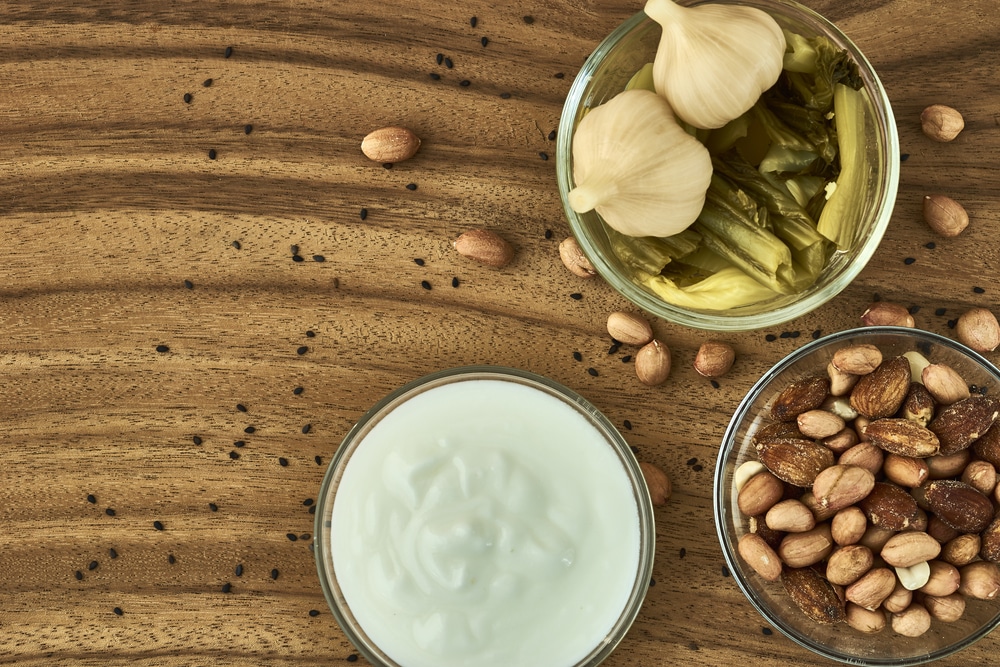Simple solutions that have a big impact on your health.
Quick: Where is your immune system? If you’re not sure, you’re not alone. Most people have no idea where the immune system resides in the body—they’re apt to think of it almost as a mythical force field.
In reality, 60 percent of your immune system’s receptor cells are in your colon and another 15 percent are in the lower part of the small intestine. That means 75 percent of your body’s immune system is at the mercy of the goings-on in your gut.
In a healthy colon, an almost countless number of friendly bacteria, or probiotics, help these immune system receptor cells do their defensive job. Probiotics inhabit the walls of the small intestine and the colon, fortifying them, forming a protective barrier that makes it harder for pathogenic bugs like E. coli and Salmonella to take root and multiply.
Power in Numbers
Ideally, beneficial probiotic bacteria make up about 85 percent of the bacteria in your GI tract. To date, scientists have identified about one hundred different kinds of probiotic bacteria. Of these, Lactobacillus acidophilus, commonly found in yogurt, is probably the best known.
Most prevalent in the small intestine where it partners with the immune system, Lactobacillus acidophilus helps digest proteins, carbs, and milk sugar and produces the lactic acid compounds that make the digestive tract acidic enough to deter potentially dangerous bacteria.
Another well-known bacterial family, the bifidobacteria, primarily populates the large intestine, where they ferment soluble fiber to feed the colon’s cells and keep pathogens at bay.
As long as these beneficial bacteria dominate, and hover around this 85 percent mark, the other 15 percent of harmful bacteria usually don’t present a problem. In a healthy gut, probiotic cells would number around 100 billion to 1,000 billion per milliliter of digestive tract.
This number ensures that probiotics have a majority strong enough to do their best job protecting your health. But when the balance starts to tip, “bad” bacteria overgrow and can cause serious health risks.
Today, many Americans have friendly flora counts as low as 5 per milliliter. Not 5 billion—just five.
That’s not just a drop—that’s a probiotic meltdown.
Clean Up Your Diet—and Clean Up Your Microbiome
If you’re worried that your beneficial bacteria numbers are dwindling, don’t fret. Dietary changes coupled with a powerful pre- and probiotic will restore health and harmony in your microbiome.
First, you must cut down and cut out all simple sugars and processed grains. These feed the yeast and fungus that can crowd out the beneficial bacteria your body needs. Also eliminate all artificial sweeteners, which can enable certain fat-forming strains of bacteria to thrive—not to mention their other negative effects. These in turn alter metabolism, slowing it down to a grinding halt, and are also known to trigger insulin resistance, encourage fat storage, and promote inflammation.
Next, pack your diet with microbiome-nourishing foods like jicama, apples, pears, cauliflower, whey protein, broccoli, berries, cherries, onions, garlic, asparagus, Jerusalem artichokes, and leeks. Special fermented foods like yogurt are also great, along with a favorite of mine—umeboshi plum paste—for seasoning, sauces, dips, and corn on the cob.
For those who enjoy garlic, it has been shown, especially in research from India, to be as effective as prescription meds in suppressing fungal overgrowth. Allicin, the ingredient in garlic that provides its distinctive flavor, also acts as a natural fungicide
Also consider incorporating coconut and MCT oil, which contain medium-chain fatty acids that have powerful antifungal properties and leave the good bacteria intact.
Fiber is also a powerhouse microbiome supporter. For rich sources try chia, flax, and hemp seeds, as well as legumes. They’ll provide the fuel for friendly flora in your gut to ferment into healing compounds that strengthen the entire microbiome.
Sweet Solutions
If you have a craving for something sweet, I have you covered there, too. I’m a big fan of a new sweetener known as yacon syrup, a prebiotic made from chicory, that will help fuel a healthy probiotic population.
Probiotics do seem to be all the range these days—and, of course, my go-to is always Flora-Key. This fantastic CFU 5-strain powdered formula provides 10 billion beneficial bacteria per serving, and contains one of the most valuable probiotic strains—Lactobacillus plantarum.
With Flora-Key you get the best of both worlds: a probiotic supported and fed by a prebiotic that can be used in cold food or drink. It’s delicious in a smoothie or for an indulgence, whipped cream. It goes great as a substitute for sugar in no-heat recipes. It’s perfect mixed into a child’s breakfast cereal—and safe for infants. You can even give a dose to your family pet.
If you’re worried that your microbiome may be a mess, these yummy pro-microbiome sweeteners and foods will have things “cleaned up” in no time.











4 Responses
Thank you sooooo much I never thought about it in my intestines awesome thank you getting on the right track thanks belessings to you
Interesting that there is a sweetener that is healthy! I didn’t know about yucon syrup. Thank you.